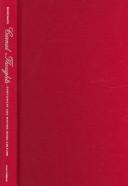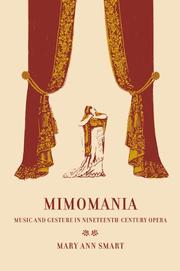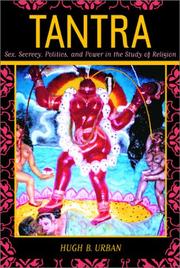| Listing 1 - 3 of 3 |
Sort by
|

ISBN: 0520937821 9786613303943 1283303949 9780520937826 1417545356 9781417545353 0520241282 9780520241282 0520241290 9780520241299 9781283303941 Year: 2004 Publisher: Berkeley : University of California Press,
Abstract | Keywords | Export | Availability | Bookmark
 Loading...
Loading...Choose an application
- Reference Manager
- EndNote
- RefWorks (Direct export to RefWorks)
In these innovative essays, Vivian Sobchack considers the key role our bodies play in making sense of today's image-saturated culture. Emphasizing our corporeal rather than our intellectual engagements with film and other media, Carnal Thoughts shows how our experience always emerges through our senses and how our bodies are not just visible objects but also sense-making, visual subjects. Sobchack draws on both phenomenological philosophy and a broad range of popular sources to explore bodily experience in contemporary, moving-image culture. She examines how, through the conflation of cinema and surgery, we've all "had our eyes done"; why we are "moved" by the movies; and the different ways in which we inhabit photographic, cinematic, and electronic space. Carnal Thoughts provides a lively and engaging challenge to the mind/body split by demonstrating that the process of "making sense" requires an irreducible collaboration between our thoughts and our senses.
Motion pictures --- Philosophy. --- Psychological aspects. --- carnality. --- cinema media studies. --- cinema scholars. --- cinematic experiences. --- contemporary culture. --- corporeal selves. --- emotional experiences. --- essay collection. --- film studies. --- film theory. --- image saturated world. --- media consumption. --- mind body split. --- modern culture. --- modern philosophy. --- moving image culture. --- nonfiction essays. --- nonfiction. --- phenomenological philosophy. --- photographic spaces. --- physical experiences. --- sense making. --- sensory experiences. --- subjects and objects. --- thoughts and senses.

ISBN: 1282358545 9786612358548 0520939875 1597347531 9780520939875 0520239954 9780520239951 9781597347532 1417545348 9781417545346 9780520248311 0520248317 9781282358546 6612358548 Year: 2004 Publisher: Berkeley, CA : University of California Press,
Abstract | Keywords | Export | Availability | Bookmark
 Loading...
Loading...Choose an application
- Reference Manager
- EndNote
- RefWorks (Direct export to RefWorks)
When Nietzsche dubbed Richard Wagner "the most enthusiastic mimomaniac" ever to exist, he was objecting to a hollowness he felt in the music, a crowding out of any true dramatic impulse by extravagant poses and constant nervous movements. Mary Ann Smart suspects that Nietzsche may have seen and heard more than he realized. In Mimomania she takes his accusation as an invitation to listen to Wagner's music-and that of several of his near-contemporaries-for the way it serves to intensify the visible and the enacted. As Smart demonstrates, this productive fusion of music and movement often arises when music forsakes the autonomy so prized by the Romantics to function mimetically, underlining the sighs of a Bellini heroine, for instance, or the authoritarian footsteps of a Verdi baritone. Mimomania tracks such effects through readings of operas by Auber, Bellini, Meyerbeer, Verdi, and Wagner. Listening for gestural music, we find resemblance in unexpected places: between the overwrought scenes of supplication in French melodrama of the 1820's and a cluster of late Verdi arias that end with the soprano falling to her knees, or between the mute heroine of Auber's La Muette de Portici and the solemn, almost theological pantomimic tableaux Wagner builds around characters such as Sieglinde or Kundry. Mimomania shows how attention to gesture suggests a new approach to the representation of gender in this repertoire, replacing aural analogies for voyeurism and objectification with a more specifically musical sense of how music can surround, propel, and animate the body on stage.
Gestes à l'opera. --- Opera --- Gesture in opera. --- Comic opera --- Lyric drama --- Opera, Comic --- Operas --- Drama --- Dramatic music --- Singspiel --- History and criticism --- 19th century. --- attention to gesture. --- auber. --- beauty. --- bellini. --- drama. --- famous composers. --- gestural music. --- live music. --- melodrama. --- meyerbeer. --- mimetic functions. --- mimomania. --- modern music. --- music and gesture. --- music criticism. --- music critics. --- music historians. --- music history. --- music studies. --- musical figures. --- musicians. --- musicology. --- nervous movements. --- nonfiction. --- opera composition. --- opera. --- pantomime. --- physical experiences. --- richard wagner. --- romantic period. --- verdi.

ISBN: 1282359614 1597349321 9786612359613 9781417525533 0520936892 9780520936898 1417525533 9781417525539 9781597349321 6612359617 0520230620 9780520230620 0520236564 9780520236561 9781282359611 Year: 2003 Publisher: Berkeley : University of California Press,
Abstract | Keywords | Export | Availability | Bookmark
 Loading...
Loading...Choose an application
- Reference Manager
- EndNote
- RefWorks (Direct export to RefWorks)
A complex body of religious practices that spread throughout the Hindu, Buddhist, and Jain traditions; a form of spirituality that seemingly combines sexuality, sensual pleasure, and the full range of physical experience with the religious life-Tantra has held a central yet conflicted role within the Western imagination ever since the first "discovery" of Indian religions by European scholars. Always radical, always extremely Other, Tantra has proven a key factor in the imagining of India. This book offers a critical account of how the phenomenon has come to be. Tracing the complex genealogy of Tantra as a category within the history of religions, Hugh B. Urban reveals how it has been formed through the interplay of popular and scholarly imaginations. Tantra emerges as a product of mirroring and misrepresentation at work between East and West--a dialectical category born out of the ongoing play between Western and Indian minds. Combining historical detail, textual analysis, popular cultural phenomena, and critical theory, this book shows Tantra as a shifting amalgam of fantasies, fears, and wish-fulfillment, at once native and Other, that strikes at the very heart of our constructions of the exotic Orient and the contemporary West.
Tantric Buddhism. --- Tantrism. --- Buddhism, Tantric --- Buddhist tantrism --- Esoteric Buddhism --- Mantrayāna Buddhism --- Mikkyō --- Tantrism, Buddhist --- Vajrayāna Buddhism --- Buddhism --- Mahayana Buddhism --- Tantricism --- Tantrism, Hindu --- Hinduism --- Magic --- Mysticism --- anthropology. --- buddhism. --- buddhist tradition. --- comparative religion. --- contemporary religion. --- critical theory. --- cultural phenomena. --- east and west. --- eastern philosophy. --- european scholars. --- faith and spirituality. --- hinduism. --- india. --- indian religions. --- jainism. --- nonfiction. --- physical experiences. --- political power. --- religious lives. --- religious practices. --- religious secrecy. --- religious studies. --- sensuality. --- sex. --- sexual politics. --- sexuality. --- tantra. --- western thought. --- western world. --- world religions.
| Listing 1 - 3 of 3 |
Sort by
|

 Search
Search Feedback
Feedback About UniCat
About UniCat  Help
Help News
News